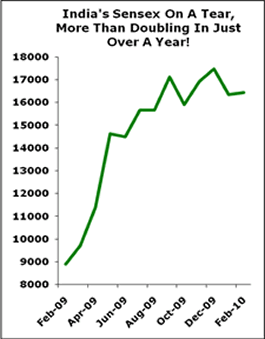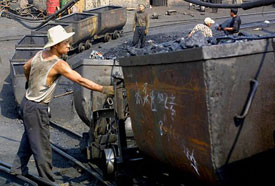India's Stock Market Sensex Index Up More Than 100% In Just Over A Year!
Stock-Markets / India Mar 29, 2010 - 08:04 AM GMTBy: Larry_Edelson
 A little over a year ago, famed newspaper columnist Dan Dorfman of The Huffington Post phoned to ask me what other Asian economy I would invest in besides my favorite, China.
A little over a year ago, famed newspaper columnist Dan Dorfman of The Huffington Post phoned to ask me what other Asian economy I would invest in besides my favorite, China.
My response: “It’s a no-brainer Dan, India!”
At the time, India’s Sensex, the equivalent of our Dow Jones Industrials, was gyrating between 8,300 and 9,300. And the world was frighteningly worried that both China and India were going to collapse as a result of the financial crisis.
I wasn’t concerned. After all, I told Dan, India had already proven itself to be one of the hottest economies on the planet and still held tremendous longer-term profit potential for investors.
 |
Today, as I pen this column, India’s Sensex is trading at 17,451 — up more than 100% since the low end of its range just over a year ago.
Many analysts and investors are still worried about India. Not me.
A. India’s economy is growing at about 7.2%. True, that’s down from the 9% growth of a couple of years ago, and India’s central bank is a bit worried about inflation, which is why it recently raised interest rates.
But 7.2% growth is still pretty torrid, more than eight times faster than the U.S. and just behind China’s still blistering growth.
The Indian economy is not merely outgrowing the U.S. by leaps and bounds; along with China, it’s one of the two major demand forces at the epicenter of the natural resource markets.
The economic growth, and the country’s influence in the natural resource markets should hardly be surprising when you consider …
B. India has the fastest-growing population in the world. Its population is adding 16 million new people per year. At that rate, India’s population will exceed 1.4 billion people and be larger than China’s by 2030.
What’s more, per-capita income in India has risen steadily and dramatically over the past five years, from roughly $285 in 2003 to about $1,000 today.
That’s a per-capita increase of more than 250% in seven years, for an average gain in incomes of about 35% per annum!
True, India’s per-capita income is still way below China’s urban per- capita income of $2,525, but incomes in India are growing faster than they are in China.
Moreover, many longer-term studies suggest that India’s per-capita income can eventually reach as much as six times that of China.
The chief reason, in my opinion: More than 21% of India’s population is English-speaking, whereas in China, less than 0.80% of the population speaks English.
Imagine what the world will be like ten or twenty years from now when the size of China’s economy is on the verge of surpassing the U.S. — AND there are 1.4 billion people in India who on average earn six times more than their industrious neighbors in China!
C. India is investing huge amounts of capital in the country’s infrastructure. India’s infrastructure is years, if not decades behind the rest of Asia, not to mention the West. And it’s the main impediment to India’s growth — today, and for the future.
But India isn’t sitting still. It’s pouring hundreds of billions of dollars into fixing dilapidated roads and highways, building new ones, erecting new power plants, shipping ports, high-speed railroads, as many as six new airports, 12 new industrial centers, and more, much more.
Indeed, just last week, India’s Prime Minister Manmohan Singh announced the government intends to more than double its $500 billion commitment to infrastructure investments — to a whopping $1 TRILLION — over the next five years.
 |
| India is pouring hundreds of billions of dollars into infrastructure. |
D. India’s manufacturing sector now accounts for almost 30% of its economy. When most analysts and investors think of India, they think of agriculture, textiles, and usually its famed information technology service industry, which handles the outsourcing for hundreds of U.S.-based computer hardware and software manufacturers and telecoms.
But in fact, India is emerging as a global, diversified manufacturing hub.
Indeed, the single largest employer in India is not the commonly mentioned service sector, but the manufacturing sector, which now employs more than 100 million people, more than 25% of the total employed in India.
And according to the United Nations Industrial Development Organization (UNIDO), on a global basis India is …
![]() Now ranked fourth after China, the U.S. and Italy in textile manufacturing …
Now ranked fourth after China, the U.S. and Italy in textile manufacturing …
![]() Fifth in the world in manufacturing electrical machinery and apparatus …
Fifth in the world in manufacturing electrical machinery and apparatus …
![]() Sixth in basic metals … seventh in chemicals and chemical products … and tenth in leather, leather products, refined petroleum products and nuclear fuel.
Sixth in basic metals … seventh in chemicals and chemical products … and tenth in leather, leather products, refined petroleum products and nuclear fuel.
Moreover, according to recent data from India’s Central Statistical Organization, India’s manufacturing output reached $46.42 billion in the July-September 2009 quarter, a gain of 9.4% over the same period a year earlier.
Indeed …
E. India’s corporate earnings this year are projected to grow an astounding 27%. Corporate earnings growth does not always guarantee higher stock prices. But it sure can help. And 27% corporate earnings growth, even if it turns out to be half that, is terrific, given all the other long-term fundamental forces converging to drive India’s economy forward.
Growth in India? It’s here to stay. India is a country to invest in, long-term. Just in its own right.
But there’s another reason I like India …
Like China, India’s Need For Natural Resources Is Huge
India does have some essential natural resources of its own, but not much and certainly not enough to keep pace with rapidly escalating demand driven by its vigorous economic growth.
For instance …
![]() India’s steel industry is averaging growth of about 8% a year as demand nearly doubles from the current level of 36 million tons of steel per year to 65 million tons by 2012. That means huge consumption of iron ore.
India’s steel industry is averaging growth of about 8% a year as demand nearly doubles from the current level of 36 million tons of steel per year to 65 million tons by 2012. That means huge consumption of iron ore.
![]() India’s copper consumption stands at about 2.5% of world consumption and even less than China’s per capita consumption. But India has already had to rely on copper imports to meet demand.
India’s copper consumption stands at about 2.5% of world consumption and even less than China’s per capita consumption. But India has already had to rely on copper imports to meet demand.
- As India’s emerging middle class rises, copper will meet much the same fate as it has in China. Huge demand that can push copper prices to the moon.
![]() Coal dominates India’s energy supply, providing more than half of its power. India’s coal consumption is expected to increase 20% in just the next two years.
Coal dominates India’s energy supply, providing more than half of its power. India’s coal consumption is expected to increase 20% in just the next two years.
![]() India’s per-capita consumption of aluminum is less than one kilogram per year. India’s aluminum consumption can be expected to climb sharply, perhaps even more than copper.
India’s per-capita consumption of aluminum is less than one kilogram per year. India’s aluminum consumption can be expected to climb sharply, perhaps even more than copper.
![]() And then there’s oil demand. Oil provides about 30% of India’s total energy consumption, and the country’s net oil imports already run at more than 2 million barrels a day.
And then there’s oil demand. Oil provides about 30% of India’s total energy consumption, and the country’s net oil imports already run at more than 2 million barrels a day.
Oil consumption in India is expected to rise sharply, effectively DOUBLING over the next two years to 4 million barrels a day.
Everyone talks about the China factor when it comes to oil prices. But once Indian demand starts to really press on oil, watch what happens to the price of black gold.
 |
| Coal dominates India’s energy supply, providing more than half of its power. |
My view: India, like China, is one heck of an economy to bet on going forward. Not only for its growth potential, but also because of its impact on the natural resource markets.
So even though in the short term, India’s Sensex is vulnerable to pullbacks, I’d be a long-term buyer on dips.
My favorite longer-term ways to own a piece of India …
1. Morgan Stanley India Investment Fund (IIF), a closed-end fund with an objective of long-term capital appreciation, and holdings that run the gamut from energy to agriculture, to mining, pharmaceuticals, telecommunications, building materials, and more.
This is a no-load fund, and its overall fees run about 1.4% per annum, less than the sector’s 1.9% average.
2. India Fund (IFN), another closed-end fund that is diversified across various industry sectors, and that seeks long-term capital appreciation. Total fees about 1.33%.
3. WisdomTree India Earnings Fund (EPI), an Exchange Traded Fund that tracks the performance of 187 of India’s top companies.
Best wishes,
Larry
P.S. If you’re not yet a Real Wealth Report subscriber, you can pick up an annual subscription — with 12 hard-hitting monthly issues … all flash alerts … and special reports for a mere $99 a year. That’s just 27 cents a day!
This investment news is brought to you by Uncommon Wisdom. Uncommon Wisdom is a free daily investment newsletter from Weiss Research analysts offering the latest investing news and financial insights for the stock market, precious metals, natural resources, Asian and South American markets. From time to time, the authors of Uncommon Wisdom also cover other topics they feel can contribute to making you healthy, wealthy and wise. To view archives or subscribe, visit http://www.uncommonwisdomdaily.com.
© 2005-2022 http://www.MarketOracle.co.uk - The Market Oracle is a FREE Daily Financial Markets Analysis & Forecasting online publication.



